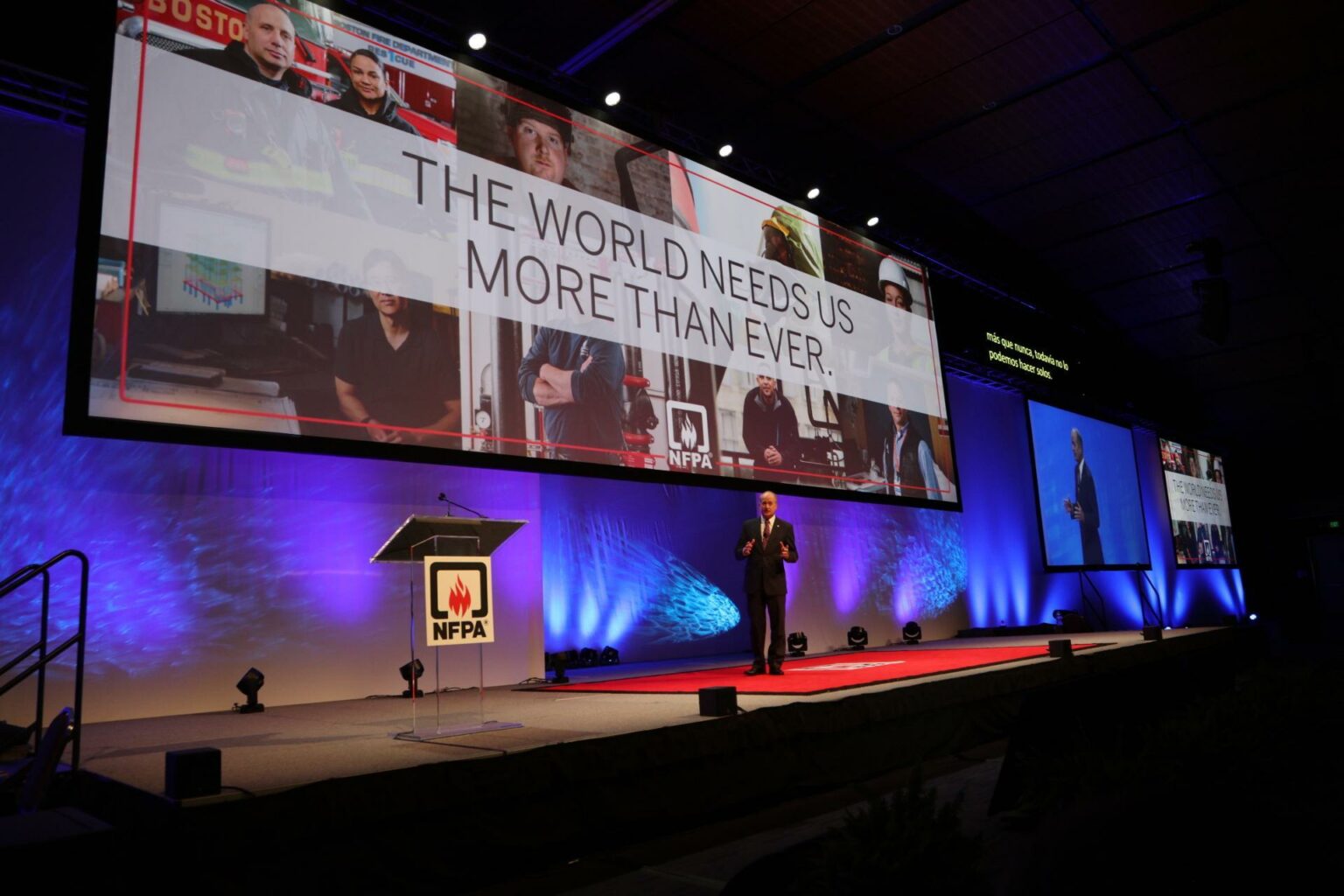Exclusive interview: Jim Pauley, President and CEO of the NFPA
- October 20, 2020
- 8:21 am

Matt Head
Share this content
International Fire and Safety Journal speaks exclusively with Jim Pauley, President and Chief Executive Officer of the NFPA.
In the US, the term ‘fire code’ is defined as a code adopted by the state or local jurisdiction and enforced by fire prevention officers within municipal fire departments – a familiar term that ensures a systematic safety procedure.
While local, state and federal authorities establish their own fire prevention and emergency laws, they pretty much all base their rulemaking on the National Fire Protection Association (NFPA) codes and standards. With more than 300 technical codes staffed by more than 9,000 volunteer experts from 43 different countries, the non-profit organisation continuously provides information based on the latest research, lessons learned and emerging issues.
International Fire and Safety Journal spoke exclusively with Jim Pauley, President and Chief Executive Officer of NFPA to find out more about the importance of codes and standards and how after nearly 125 years in the industry, the association plans on meeting the various fire and safety demands of today.
Adapting to current needs
Discussing today’s standards and safety values, Pauley stated: “I believe we have now let it get to the point where people take standards for granted. Yes, they still exist and are implemented when buildings are being constructed, but we at NFPA are trying to raise the level of awareness surrounding these standards by constantly providing information and by staying relevant to today’s issues.
“Like any business organisation, you must adapt and adjust – we have hundreds of different codes and standards that are updated with time. The vast majority are revised every three years or so. Having correct codes and standards is critical to meeting the fire safety demands of today. NFPA codes and standards ultimately cover a wide range of topics and thus the reason we have a broad spectrum of stakeholders.”
For example, NFPA’s research affiliate, The Fire Protection Research Foundation, has been doing research into enhanced cleaning of fire personnel protective equipment (PPE) – specifically looking into how clean their equipment is after an incident and how it is protecting firefighters appropriately from the toxins that naturally occur in those environments. With occupational exposure being such a big focus in recent years and, more recently, COVID-19 raising new concerns, the topic of PPE cleaning is certainly relevant.
Pauley also spoke about the association’s fire protection efforts: “We are looking at cybersecurity for fire protection systems, as well as technology trends. Another good example is NFPA 855 Standard for the Installation of Stationary Energy Storage Systems. The topic of ESS has become more popular today, but NFPA developed the world’s first ESS training more than five years ago and then it was updated last spring.
“The Research Foundation also recently released new research on sprinkler energy storage units. We have found that by staying connected and adjusting to whatever the most pressing fire and safety issues are today, we are able to successfully transfer the right information to the people that need it the most.”
Fire & Life Ecosystem: Broadening the lens
To further minimise the risk of fire, the organisation developed the NFPA Fire & Life Ecosystem – a unique framework that works to prevent loss, injuries and death from fire, electrical and other hazards. The impetus for the Ecosystem began when Pauley was travelling around parts of the world in 2017, discussing different catastrophic fire events that were occurring at the time.
He explained: “We were seeing these tragic events occur around the same time as Grenfell; the wildfires in Portugal, the ship fire in the US, the Notre Dame fire in Paris – all of these made us think ‘are we really looking at these through the right lens?’
“We found that everybody was looking at these events through a singular lens based on their particular fire safety component – for example, fire suppressant manufacturers would be blamed for the lack of appropriate suppressant solutions, an enforcer would be criticised for not implementing the correct rules and labour skills were often scrutinised. We were mistakenly looking at safety in a vacuum. The Ecosystem was created to encourage people to take a holistic approach to safety.”
The Ecosystem consists of eight integral components; Government Responsibility, Development and Use of Current Codes, Referenced Standards, Investment in Safety, Skilled Workforce, Code Compliance, Preparedness and Emergency Response and an Informed Public. NFPA challenges different authorities to determine which Ecosystem element or series of elements did not perform to the level they should have when a disaster occurs.
“I think the best way to describe the Ecosystem is to foster the mindset that safety is a system rather than a singular element. I have to admit the Ecosystem has been a very successful barometer for the fire and safety sector and has fostered forward-thinking conversations,” Pauley added. “It has been translated into eight different languages now and the most exciting part is hearing people say, ‘this is exactly what I have been wanting to see in the market, but have never been able to vocalise.’ We have broadened the approach to fire risk management and I think that’s what makes this such a unique framework.”

Conduct through COVID
As the threat of coronavirus began to grow in the US this past spring, NFPA quickly mobilised to ensure that people in various safety roles had the information they needed to help mitigate impact and protect communities. This content was designed to help policy makers, emergency responders, code officials, health care officials, facility managers and the public navigate the new normal that came with COVID-19. It delved into ITM (inspection, testing and maintenance) of fire protections systems, closing and reopening buildings, dealing with new 911 protocol and even the dangers that might accompany hand sanitisers.
“We had a lot of situations where temporary hospitals needed to be constructed so we had to generate real world guidance that covered the important life safety elements that need to be implemented in a medical environment,” Pauley explained.
“I suspect that when our technical committees start to get back together, we are going to see more discussions about temporary hospitals. But the environment was not going to wait on the committee recommendations, so it was ultimately about us trying to gather the relevant insights and sharing that information via our social media channels, articles, blogs, press releases and media interviews so that people charged with moving forward in the interest of safety had the right information to do so.”
With more and more people working remotely this year, NFPA worked hard to ensure that there would not be a decrease in the ITM of fire and life safety systems, such as sprinklers, throughout office buildings.
Pauley said: “People were saying, ‘the building is empty so what is the urgency?’ So, we began putting out information about the critical role that ITM personnel play and the fact that they should be deemed essential workers during the pandemic.
“Additionally, we had to consider school strategies during COVID-19. For example, how to conduct a fire drill while trying to maintain social distancing. For this, schools need to work with local officials to think in terms of what is a reasonable exiting time and potentially creating temporary distance markers so students can congregate at their assembly points at a safe proximity.
“In general, it has been less about big alterations for standards and more about responding to needs very quickly as they arise; and I think those needs will get carried over as the standards go back into their cycles.”
Middle Eastern presence
NFPA has a long-standing presence in the Middle East – for decades, the organisation has been working with government officials and private entities responsible for building, fire and life safety in the Gulf region.
“I was in a jurisdiction in the Middle East and we were talking to the people responsible for enforcement and one of the questions was, ‘how do you handle a sudden change of occupancy? For example, a bakery owner wanted his business to become a night club the next day. Now, if this were to happen in the US or the UK, new permits and requirements would have to be put in place and it would definitely need to be re-inspected.”
Pauley continued: “This element is missing in the Middle East enforcement system so we had a long discussion about how this change could be implemented properly. It is ultimately not standards that they should be focused on, it is all of the supporting elements of the system.
“Their use of standards is moving forward but it is very technical and that’s when discussion becomes even more important. You need to consider all of the other safety elements in the Eco-system – just having the standard is not the only answer.”
NFPA LiNK
Outlining NFPA’s plans for the next year, Pauley stated: “Our focus is going to be on how we deliver information and knowledge to our stakeholders across the globe. We just launched a brand-new, digital information platform called NFPA LiNK. NFPA LiNK is a prime example of how NFPA is innovating. Despite being over a century old, our organisation knows that we can no longer simply offer a code or a standard. More importantly, we need to provide a wide range of people with the information and insights that will help them solve problems and do their jobs more successfully.”
Pauley concluded: “We are changing how we deliver critical safety information – how it is packaged, how people can gain access to it. We are revisiting the way people can use our codes and standards on a daily basis – I can tell you, it is an exciting time at NFPA because we know that with each innovation, we are meeting our stakeholders where they are.”
This article was published in the latest edition of International Fire and Safety Journal. Pick up your FREE digital copy here



